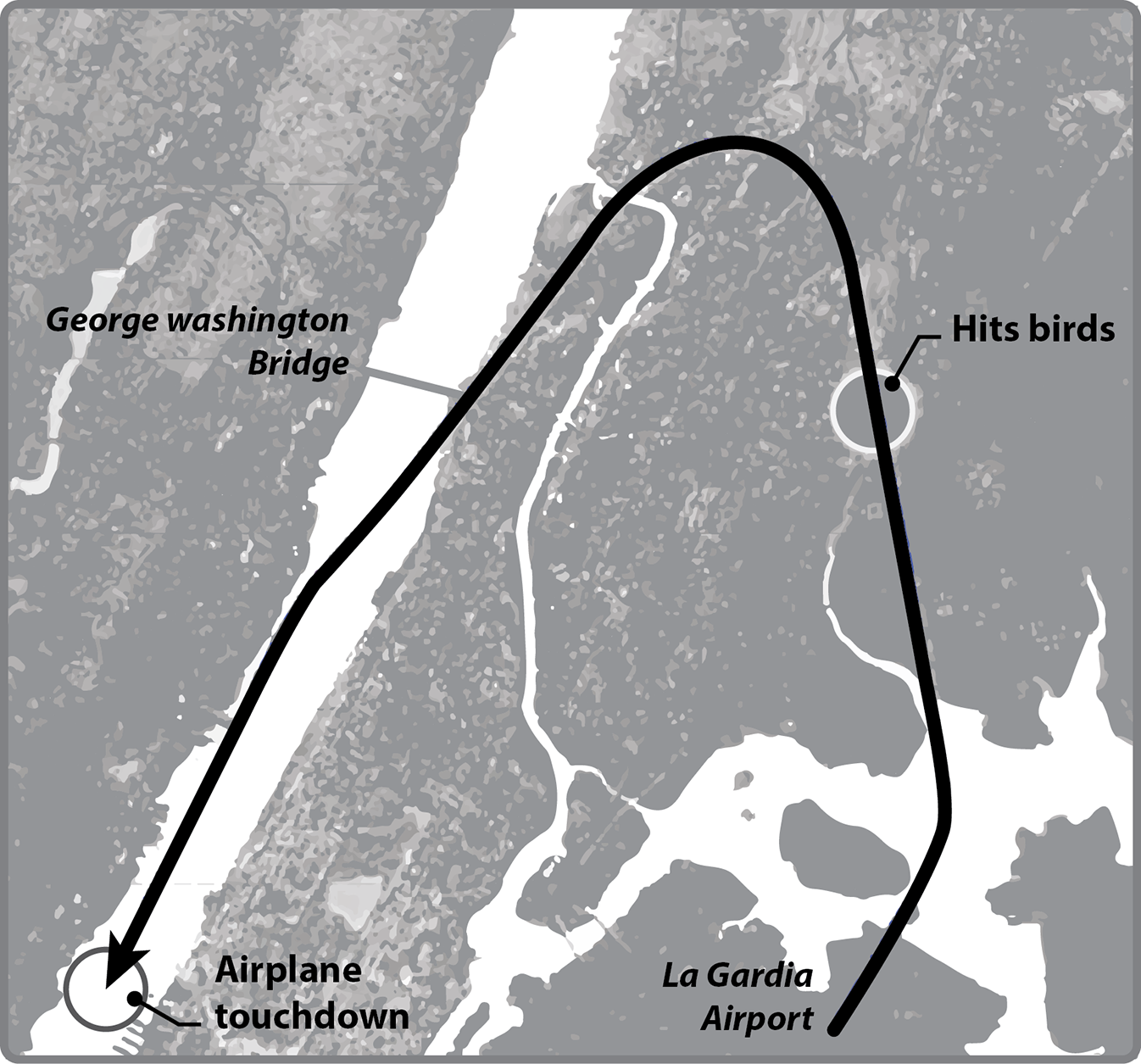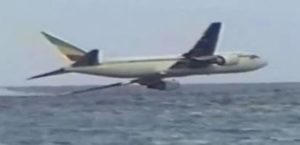In our book we just wanted to put Sully’s feat into perspective by mentioning that other pilots have faced and resolved even more difficult situations though perhaps not so scary.
One comparison was with the “Gimli Glider Incident” (in Chapter 2) where an Air Canada Boeing 767 ran out of fuel with only a tiny disused airfield at Gimli in reach. Coming in too high and much too fast the captain used the skills learnt as a glider pilot to lose that height and speed and touch down with no loss of life. A perhaps greater feat than the one achieved by Sully, who too had glider pilot skills but as we said just did not need them.
Another comparison we made was with the ditching of the Ethiopian airliner off a beach as shown in the photo below.
A wing and engine snagged the water first and the aircraft began to spin round and break apart, with passengers who had prematurely inflated their life vests trapped when water came in. Commentators wasted no time in pointing out how much better Sully had done with no lives lost. However, with no electrical power to properly power the computers, a sea with a swell rather than a calm river, and having to fight off a hijacker with one hand, the Ethiopian pilot faced a far more difficult task. In fact, one of the best things Sully did after the bird strike was to immediately restart the auxiliary generator to power the computers to help fly the aircraft, something the Ethiopian pilot with no fuel could not do.
Ethiopian Airlines Ditching
We end the piece on Sully’s feat as follows:
Sully’s flying skill—the thing for which, ironically, the public hold him in such high esteem—was the area where he performed creditably but not exceptionally. He let his airspeed fall too low and thus was unable to make an effective flare to break the excessive sink rate, which ultimately resulted in the panels under the tail section breaking and letting in water and the shock injuring the flight attendant sitting there. The NTSB investigators attributed this failure to maintain airspeed to tunnel vision brought about by lack of time, stress, work overload, the distractions of various alarms, the off-putting sight of skyscrapers alongside, and concentrating on maneuvering the aircraft, coupled with the fact that other audible warnings were prioritized over airspeed warnings at that low height.
They pointed out that without thrust from the engines, it would be extremely difficult for any pilot to achieve the recommended ditching speeds, assuming he or she knew them. However, Sully did strike the water with the wings virtually level, and at such an angle the aircraft did not spin, cartwheel, or break up. He did well enough, but other than keeping his nerve while performing that maneuver, he probably did not need all the talents developed from the age of three onwards extolled in his autobiography.
With the rear of the aircraft damaged and icy water coming in, perhaps the real miracle was the rescue, with not a single fatality thanks to the diligence of so many—boatmen, helicopter men, not forgetting Sully, who checked so thoroughly that everyone was out and gave advice and assistance to those in difficulty. This was also thanks to the cabin crew, all with twenty if not thirty years’ experience, showing there is something to be said for that. Admittedly, an average domestic flight might well have had more passengers with impaired mobility and made their task more difficult.
One of the many lessons noted by the NTSB investigators is a little chilling for those of us confined in seats so close to the one in front that in adopting the brace position we cannot bend fully over and grab our ankles, and instead have to press on the top of the back of the seat in front with our hands or arms. Two female passengers so doing suffered a shoulder fracture.
A man generously took charge of the baby a mother was carrying on her lap, but had the deceleration been far greater he might not have been able to save it as he did. Babies and infants in arms should ideally have their own seats and restraints; however, that might mean people unable to afford the extra seat would travel by road, which is far more dangerous.
One gratifying endnote is that the passengers who risked the lives of their fellow passengers and cabin crew by bringing their luggage with them lost it in the river, while those that did not got it returned.
Notwithstanding all we have said, one cannot take away Sully’s achievement. Just imagine the gut-wrenching feeling he had to overcome on finding himself engineless over a packed city with no height to play with.
Great pilots like great generals, as Napoleon said, need luck.
What is more, because he is clearly such a fine, upstanding person, Sully has been able to exploit his fame for good.
________________________________________
Referring to the movie we said:
The movie Sully, with Tom Hanks as a very credible and likeable Sully, proved a big box office hit in the US and abroad, in great part by making the hero look even more heroic, at the expense of the NTSB investigators.
Unlike the gripping movie Apollo 13, where the high drama lasted three days as the capsule with the three astronauts circled the moon, this incident lasted a mere three minutes from the moment of the bird strike to coming down safely on the water. Therefore, to hold cinemagoers’ interest, the filmmakers introduced scenes showing Sully imagining his aircraft hitting Midtown buildings in 9/11 style, and more disconcertingly created a false scenario in which Sully and Skiles are portrayed as victims of a drawn-out NTSB witch hunt, the dramatic finale being that public hearing at the NTSB, at which Sully pulls a cat out of a bag to dramatically prove for all to see that the callous investigators were totally wrong because they had forgotten to factor in “thinking time.” In fact, as said, it was the NTSB’s idea to factor it in and say he could not have got back to LaGuardia and had indeed acted correctly.
The writer of a glowing 5-star review of Air Crashes and Miracle Landings on Amazon UK said the only negative he could find was our disparaging Sully’s flying skills and “missing no opportunity to question them.”
With the book starting with Amelia Earhart and the loss of power over water the reader too quickly comes upon our analytical account of Sully’s exploit. The comparisons we make really refer to the circumstances rather than question his flying skills. The title of the piece “Where did the Miracle on The Hudson Lie?” was a little confusing for though the double-entendre meaning of “Lie” was intentional we really meant the miracle LAY in the rescue from the Hudson partly thanks to the fact that the domestic flight happened to have life rafts. We will shortly try to correct this by adding a sentence at the end saying so.
We would welcome comments.


